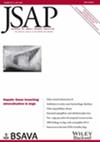Complication rates associated with nasoesophageal versus nasogastric feeding tube placement in dogs and cats: a randomised controlled trial
Abstract
Objectives
To determine the rate of accidental placement of nasoenteric tubes into the respiratory tract. To compare the methods of checking correct tube placement. To compare the complication rates between nasoesophageal and nasogastric tubes.
Materials and Methods
Animals requiring nasoenteric feeding tubes were prospectively randomised to have either nasoesophageal or nasogastric tube placement. Various techniques for assessing tube position were compared with thoracic radiographic findings. Complications during placement and use were recorded.
Results
Ninety-seven animals (82 dogs and 15 cats) were studied. The tube was misplaced into the respiratory tract in three (3.1%) cases. No technique for checking placement was completely concordant with radiography but the presence of negative pressure at the thoracic inlet during placement was consistent with the presence of the tube in the oesophagus in 86.2% cases, while capnography can be considered to confirm tracheal placement. The overall rate of complications during tube placement was 25.8%, with mostly minor clinical complications reported. There was no significant difference in the new-onset regurgitation/vomiting rate, or complications while the tube was in situ between the nasoesophageal and nasogastric groups.
Clinical Significance
Misplacement of nasoenteric tubes is uncommon but a consistent alternative test to radiography for checking correct nasoenteric tube placement was not demonstrated. The choice of placement of either a nasoesophageal or nasogastric tube should be guided by clinician preference, and clients should be warned about possible complications during placement and while the nasoenteric tube is in situ.

 求助内容:
求助内容: 应助结果提醒方式:
应助结果提醒方式:


